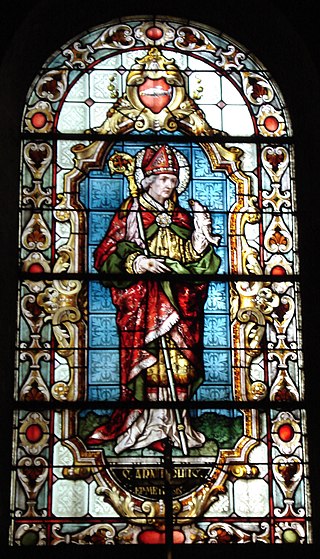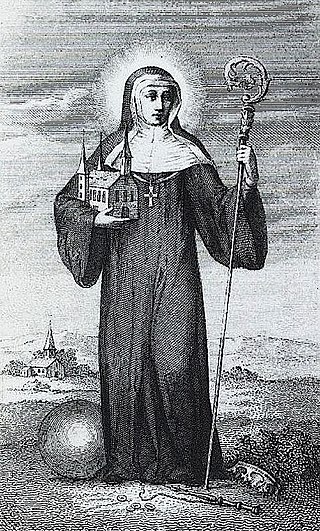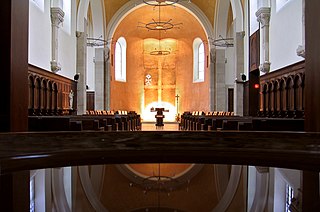Related Research Articles

Balthild, also spelled Bathilda, Bauthieult or Baudour, was queen consort of Neustria and Burgundy by marriage to Clovis II, the King of Neustria and Burgundy (639–658), and regent during the minority of her son, Chlothar III. Her hagiography was intended to further her successful candidature for sainthood.

Arnulf of Metz was a Frankish bishop of Metz and advisor to the Merovingian court of Austrasia. He later retired to the Abbey of Remiremont. In French he is also known as Arnoul or Arnoulf. In English he is known as Arnold.

Dagobert II was a Merovingian king of the Franks, ruling in Austrasia from 675 or 676 until his death. He is one of the more obscure Merovingians. He has been considered a martyr since at least the ninth century.

Amandus, commonly called Saint Amand, was a bishop of Tongeren-Maastricht and one of the catholic missionaries of Flanders. He is venerated as a saint, particularly in France and Belgium.

Gertrude of Nivelles, OSB was a seventh-century abbess who, with her mother Itta, founded the Abbey of Nivelles, now in Belgium.

Vedast or Vedastus, also known as Saint Vaast or Saint Waast, Saint Gaston in French, and Foster in English was an early bishop in the Frankish realm. After the victory of Tolbiac Vedast helped instruct the Frankish king Clovis in the Christian faith of his wife, Queen Clotilde.

Sadalberga was the daughter of Gundoin, Duke of Alsace and his wife Saretrude. Sadalberga founded the Abbey of St John at Laon. She is the subject of a short hagiography, the Vita Sadalbergae.

Burgundofara, also Saint Fara or Fare, was the founder and first abbess of the Abbey of Faremoutiers.
Chagnoald was a Frankish bishop of Laon during the 7th century. The family to which Chagnoald belonged is known as the Faronids, named after his brother Saint Faro, who was bishop of Meaux, while his sister was Saint Burgundofara, who founded the convent of Faremoûtiers. They were the children of the chancellor to Dagobert I, Chagneric.
Gundoin was the first Duke of Alsace in the middle of the seventh century. He was a Frankish nobleman from the Meuse-Moselle basin. He was, according to the author of the Vita Sadalbergae, an "illustrious man, opulent in wealth and fame according to the highest secular dignity and skilled in courtly affairs."

Saint Wandregisel was a Frankish courtier, monk, and abbot.
Eustadiola (594–684) was a saint, widow, and abbess. She was born to wealthy and politically powerful parents in Bourges, France. She married due to pressure from her family, but became a widow at a young age, which gave her the financial and social independence to live what Sainted Women of the Dark Ages centuries later called a "semiretired religious life". She gave away her wealth to the poor, founded churches, monasteries, and convents, and used her wealth and influence to expand and decorate the buildings. Eustadiola was abbess of the convent she founded in Bourges, and lived as an ascetic for 70 years. Many miracles and healings were attributed to her. Her feast day is celebrated on 8 June.
Baudonivia was a nun and hagiographer at the convent of Holy Cross of Poitiers. Very little is known about her. She wrote a biography of Radegund, Queen, founder of Holy Cross, and saint. Scholars have noticed a marked difference in perspective between an earlier life of Radegund composed by Venantius Fortunatus, written from a close friend's perspective, and Baudonivia's, written from the perspective of a nun of Radegund's own convent.

Irmina of Oeren was a saint, founder and abbess of a convent in Oeren, near Trier (Trèves), and co-founder of a convent in Echternach. Hagiographer Basil Watkins states that Irmina's 12th century biography is "unreliable" and it is likely that "legends about her family tree spiralled out of control", but she came from one of the most powerful families in the Merovingian kingdom. She might have been Saint Primina, the daughter of Dagobert I and sister of Saint Modesta. She might have been the daughter of Dagobert II and sister of Saint Adela of Pfalze. Historian Ian Wood stated that Irmina is "traditionally, and probably correctly, identified as Plectrude's mother".
The Vita Dagoberti is an anonymous Latin biography of Dagobert III, king of the Franks (711–716). It is unreliable as a historical source. Confusing Dagobert III and the assassinated Dagobert II, the author mistakenly treats Dagobert III as a Christian martyr. The Vita is thus a saint's life, although its subject was not a saint.

Balda of Jouarre was the third abbess at Jouarre Abbey in north-central France. She was a nun at Jourarre for many years, under her nieces Theodichildis and Agilberta, who were abbesses before her. Her nephew, Agilbert, was bishop of Paris. She might have been related to Sadalberga.
Although Merovingian Francia is not considered a slave society, slaves were, nonetheless, present throughout the entirety of the dynasty and well into the Carolingian period and beyond. In the 7th century, however, the sale and trade of Christians within Frankish borders was abolished by Queen Balthild, herself a former slave.

The Gesta Dagoberti, fully Gesta domni Dagoberti regis Francorum, is an anonymous Latin biography of Dagobert I, king of the Franks (623–639). It combines deeds from the life of Dagobert with numerous accounts of miracles to present Dagobert as a saint and the founder of the Abbey of Saint-Denis. It was written in the early 9th century. As a historical source, it is "extremely unreliable", but not totally useless.

Rusticula, also called Marcia, was the abbess of Saint-Jean d'Arles from 575 until her death.
Caesaria the Younger or Caesaria II was the abbess of Saint-Jean d'Arles from around 525 until her death.
References
- 1 2 3 J. A. McNamara, J. E. Halborg, E. G. Whatley, eds. Sainted women of the Dark Ages (Duke University Press, 1992), p. 176.
- ↑ P. S. Barnwell (2005), "II. Late Antiquity and the Early Middle Ages (300–900)", Annual Bulletin of Historical Literature89(1), 5–12.
- 1 2 P. J. Fouracre, (2008), "Forgetting and Remembering Dagobert II: The English Connection", in Frankland: The Franks and the World of the Early Middle Ages (Manchester: Manchester University Press), p. 73.
- ↑ Jamie Kreiner, The Social Life of Hagiography in the Merovingian Kingdom (Cambridge University Press, 2014), p. 189.
- ↑ H. J. Hummer, Politics and Power in Early Medieval Europe: Alsace and the Frankish Realm, 600–1000 (Cambridge University Press, 2006), p. 41.